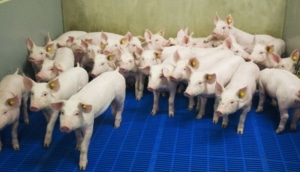More than a year ago Daavision launched the Plan of Approach Salmonella. A clear approach that gives pig farmers the tools to control their Salmonella status. Pig farmers in the Netherlands and abroad have successfully incorporated the Plan of Approach into their day-to-day business. Innovation manager Willem Ederveen shares his views about the approach.
“Acknowledging that salmonellosis is a multifactorial infection is step one”, says Willem Ederveen. “Among the new pigs that enter the farm are often animals that are infected with Salmonella. These carriers may excrete Salmonella bacteria through their manure. This manure is a source of infection for other pigs within the group. The severity of the infection depends on the pigs resistance”, Ederveen explains.
“Salmonellosis is a multifactorial infection”
Many pig farmers recognize the importance of improving the Salmonella status. By improving the status at their farms they reduce the risk of possible sanctions. Mid 2015 the German slaughterhouse Westfleisch announced a rewarding system for pig farms in category I. These farms receive a reward of 40 cents per pig if they deliver pigs in category I.
“Detecting a Salmonella infection is not always easy. Salmonellosis is not often detectable by the naked eye. Nevertheless, there are situations in which a carrier excretes more Salmonella bacteria than normal. For example during transport and when entering a new barn. Clinical signs such as lethargy, fever, diarrhea and an increased mortality rate can indicate a Salmonella infection”, says the innovation manager. “Before we start with the Plan of Approach we map the situation at the farm together with the veterinarian. The walking lines, visitor protocol, cleaning and desinfection plan, manure removal and hygiene of the drinking water are aspects that are being examined”, explains Ederveen. “Biosecurity is an important element when aiming to improve the Salmonella status.”
“We establish the initial situation by taking 12 blood samples and one pooled manure sample. The blood samples give us a good indication of the infection pressure at the farm. Only when everything is mapped, the water pipes are cleaned and necessary adjustments are made we will start dosing the Daaqusafe”, he continues. “Ten to twelve weeks after the start of the Plan of Approach we take new blood samples and evaluate the titers. When the titers are reduced sufficiently we move on to the next phase. If this is not the case, then we determine the cause in collaboration with the veterinarian. We then repeat the first phase and take blood samples once more. So that we can directly tackle the Salmonella infection.” In practice Ederveen regularly sees that the recommended dosage is not applied properly. The infection pressure is not sufficiently reduced. At least two rounds are necessary when lowering the titers of finishing pigs. He observes good results at farms that consistently pay attention to biosecurity and constantly dose a stable amount of organic acids.
“At these farms the titers are reduced and eventually stabilize. The overall results of the last three trimesters improve and the company shifts from category III, the most unfavorable category, to category II. We notice that the participating companies continue using Daaquasafe after their improvement. Many of them strive to end up in category I, with success. Of course the risk of Salmonella infection remains present when new pigs, that may be carriers, enter the farm”, concludes Ederveen.



